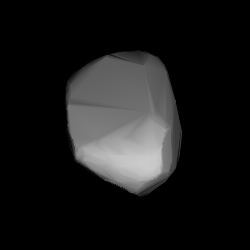 Shape model of Druzhba from its lightcurve | |
| Discovery [1] | |
|---|---|
| Discovered by | S. Belyavskyj |
| Discovery site | Simeiz Obs. |
| Discovery date | 1 October 1926 |
| Designations | |
| (1621) Druzhba | |
Named after | дружба – lit. friendship (in Russian) [2] |
| 1926 TM ·1927 AE 1931 EO ·1946 UH 1949 QS1 ·1951 EK1 1951 ER1 ·1958 GA 1979 QP4 | |
| main-belt · Flora [3] | |
| Orbital characteristics [1] | |
| Epoch 4 September 2017 (JD 2458000.5) | |
| Uncertainty parameter 0 | |
| Observation arc | 90.49 yr (33,052 days) |
| Aphelion | 2.4948 AU |
| Perihelion | 1.9650 AU |
| 2.2299 AU | |
| Eccentricity | 0.1188 |
| 3.33 yr (1,216 days) | |
| 73.187° | |
| 0° 17m 45.6s / day | |
| Inclination | 3.1730° |
| 181.88° | |
| 238.14° | |
| Physical characteristics | |
| Dimensions | 9.05 km (derived) [3] 9.08±0.8 km [4] 11.70±0.20 km [5] 12.694±0.296 km [6] |
| 12 h (dated) [7] 47.9±0.5 h (dated) [8] 99.100±0.005 h [9] 99.20±0.03 h [10] | |
| 0.2373±0.046 [4] 0.243 (derived) [3] 0.244±0.039 [6] 0.312±0.012 [5] | |
| Tholen = S [1] · S [3] [11] B–V = 0.898 [1] U–B = 0.503 [1] | |
| 11.63 [1] [5] [6] ·12.37±0.09 [3] [7] [12] ·12.39 [4] ·12.53±0.29 [11] | |
1621 Druzhba (provisional designation 1926 TM), is a stony Florian asteroid and relatively slow rotator from the inner regions of the asteroid belt, approximately 10 kilometers in diameter. It was discovered on 1 October 1926, by Russian astronomer Sergey Belyavsky at Simeiz Observatory on the Crimean peninsula. [13] It was named after the Russian word for friendship. [2]